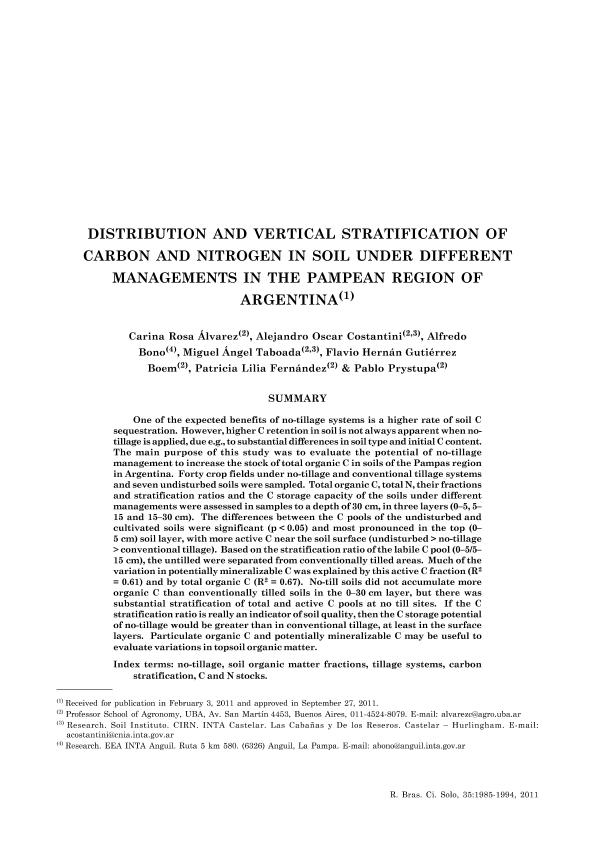Artículo
One of the expected benefits of no-tillage systems is a higher rate of soil C sequestration. However, higher C retention in soil is not always apparent when notillage is applied, due e.g., to substantial differences in soil type and initial C content. The main purpose of this study was to evaluate the potential of no-tillage management to increase the stock of total organic C in soils of the Pampas region in Argentina. Forty crop fields under no-tillage and conventional tillage systems and seven undisturbed soils were sampled. Total organic C, total N, their fractions and stratification ratios and the C storage capacity of the soils under different managements were assessed in samples to a depth of 30 cm, in three layers (0-5, 5-15 and 15-30 cm). The differences between the C pools of the undisturbed and cultivated soils were significant (p < 0.05) and most pronounced in the top (0-5 cm) soil layer, with more active C near the soil surface (undisturbed > no-tillage > conventional tillage). Based on the stratification ratio of the labile C pool (0-5/5-15 cm), the untilled were separated from conventionally tilled areas. Much of the variation in potentially mineralizable C was explained by this active C fraction (R 2 = 0.61) and by total organic C (R 2 = 0.67). No-till soils did not accumulate more organic C than conventionally tilled soils in the 0-30 cm layer, but there was substantial stratification of total and active C pools at no till sites. If the C stratification ratio is really an indicator of soil quality, then the C storage potential of no-tillage would be greater than in conventional tillage, at least in the surface layers. Particulate organic C and potentially mineralizable C may be useful to evaluate variations in topsoil organic matter. Um dos benefícios esperados do uso do plantio direto é um maior sequestro de C. Contudo, nem sempre se observa maior retenção de C no solo quando esse sistema de preparo é utilizado, devido principalmente às diferenças em tipo de solo e conteúdo inicial de C, entre outras. O objetivo deste trabalho foi avaliar o potencial do plantio direto para estocar C orgânico nos solos da Região do Pampa Argentino. Foram coletadas amostras de solo em 40 áreas sob plantio direto ou preparo convencional e em sete campos não cultivados por vários anos. Determinaram-se o C orgânico total, N total, suas frações lábeis, sua taxa de estratificação e a capacidade de estocar C dos solos sob diferentes manejos, na camada de 0-30 cm de profundidade, a qual foi dividida, para fins de amostragem, em três profundidades (0-5, 5-15 e 15-30 cm). Verificou-se diferença significativa (p < 0,05) para todos os pools de C entre os solos não cultivados e os cultivados. A diferença mais pronunciada foi verificada na camada superficial (0-5 cm), sendo determinado o maior teor de C lábil próximo da superfície do solo (não perturbado > plantio direto > preparo convencional). A taxa de estratificação do C lábil (0-5/5-15 cm) permitiu separar as áreas sob plantio direto daquelas sob preparo convencional. Boa parte da variação em C potencialmente mineralizável foi explicada pela fração lábil do C (R2 = 0,61), assim como pelo C orgânico total (R2 = 0,67). Os solos sob plantio direto não estocaram mais C orgânico do que os preparados de maneira convencional, na camada de 0-30 cm. Entretanto, houve substancial estratificação dos pools de C lábil nos locais sob plantio direto, indicando que, se a taxa de estratificação for realmente um indicador de qualidade de solos, as áreas sob plantio direto poderiam ter maior potencial de acúmulo de C, pelo menos nas camadas superficiais de solo, se comparada com as áreas sob preparo convencional. O C orgânico particulado e o C potencialmente mineralizável podem ser utilizados para avaliar variações na matéria orgânica da camada superficial do solo.
Distribution and vertical stratification of carbon and nitrogen in soil under different managements in the Pampean region of Argentina
Título:
Distribuição e estratificação vertical do carbono e nitrogênio em solos sob diferentes manejos na região do Pampa Argentino
Alvarez, Carina Rosa ; Costantini, Alejandro Oscar
; Costantini, Alejandro Oscar ; Bono, Alfredo; Taboada, Miguel Angel
; Bono, Alfredo; Taboada, Miguel Angel ; Gutiérrez Boem, Flavio Hernán
; Gutiérrez Boem, Flavio Hernán ; Fernández, Patricia Lilia; Prystupa, Pablo
; Fernández, Patricia Lilia; Prystupa, Pablo
 ; Costantini, Alejandro Oscar
; Costantini, Alejandro Oscar ; Bono, Alfredo; Taboada, Miguel Angel
; Bono, Alfredo; Taboada, Miguel Angel ; Gutiérrez Boem, Flavio Hernán
; Gutiérrez Boem, Flavio Hernán ; Fernández, Patricia Lilia; Prystupa, Pablo
; Fernández, Patricia Lilia; Prystupa, Pablo
Fecha de publicación:
11/2011
Editorial:
Sociedade Brasileira de Ciência do Solo
Revista:
Revista Brasileira de Ciência do Solo
ISSN:
0100-0683
e-ISSN:
1806-9657
Idioma:
Inglés
Tipo de recurso:
Artículo publicado
Clasificación temática:
Resumen
Archivos asociados
Licencia
Identificadores
Colecciones
Articulos(INBA)
Articulos de INST.DE INVEST. EN BIOCIENCIAS AGRICOLAS Y AMBIENTALES
Articulos de INST.DE INVEST. EN BIOCIENCIAS AGRICOLAS Y AMBIENTALES
Articulos(SEDE CENTRAL)
Articulos de SEDE CENTRAL
Articulos de SEDE CENTRAL
Citación
Alvarez, Carina Rosa; Costantini, Alejandro Oscar; Bono, Alfredo; Taboada, Miguel Angel; Gutiérrez Boem, Flavio Hernán; et al.; Distribution and vertical stratification of carbon and nitrogen in soil under different managements in the Pampean region of Argentina; Sociedade Brasileira de Ciência do Solo; Revista Brasileira de Ciência do Solo; 35; 6; 11-2011; 1985-1994
Compartir
Altmétricas



